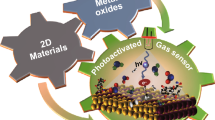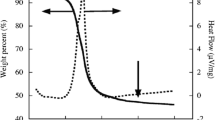Abstract
In this present work, bismuth oxide (based on Bi2O3) and zinc oxide (ZnO-doped) thin films were produced by thermal evaporation (RT) method on 50-nm-thick glass substrates and annealed at 573 K. SEM showed that the (Bi2O3/ZnO) nanoparticles were evenly dispersed throughout when the ZnO doping concentration was increased. The actual result of the optical characteristics of (Bi2O3/ZnO) showed that (extinction coefficient, refractive index, real part and imaginary part of the dielectric constant) increase with increasing concentrations of ZnO nanoparticles. This behavior makes them excellent optical materials for photonics applications. The results of the D.C electrical characteristics show that the D.C electrical conductivity of the (Bi2O3/ZnO) nanocomposites increases with increasing nanoparticle (ZnO) concentrations and temperature. At the same time, the resistance and activation energy decrease with increasing nanoparticle (ZnO) concentrations. The measured gas sensor revealed a sensitivity to H2S of about 69.74% at 200 °C, decreasing to about 55.14% at 250 °C and 51.42% at 300 °C. Finally, the results of the structural and conductive characteristics of (Bi2O3/ZnO) thin films can be used in various nanoelectronics devices and gas sensors. Finally, the results expected that metal oxide nanostructures will prove to be the most effective building blocks for developing cutting-edge gas sensors. The effects of various doping’s on the morphology and crystal structure of ZnO materials are examined in depth in this article. This article provides sound advice for developing high-performance semiconductor oxide sensing materials based on zinc oxide (ZnO).














Similar content being viewed by others
Availability of Data and Material
Yes, the data and material are available.
References
M. Wang, T. Wang, P. Cai, X. Chen, Nanomaterials discovery and design through machine learning, small. Methods 3, 1–7 (2019). https://doi.org/10.1002/smtd.201900025
J. Wright, Nanotechnology: deliver on a promise. Sci. Am. 311, S12–S13 (2014). https://doi.org/10.1038/scientificamerican0714-S12
X. Li, X. Liu, J. Huang, Y. Fan, F.Z. Cui, Biomedical investigation of CNT based coatings. Surf. Coat. Technol. 206, 759–766 (2011). https://doi.org/10.1016/j.surfcoat.2011.02.063
Y. Bai, C. Wang, J. Gao, J. Su, W. Ma, A study on dispersion and antibacterial activity of functionalizing multi-walled carbon nanotubes with mixed surfactant. J. Surfactants Deterg. 18, 957–964 (2015). https://doi.org/10.1007/s11743-015-1729-z
S.M. Hosseinpour-Mashkani, M. Maddahfar, A. Sobhani-Nasab, Novel Silver-doped NiTiO3: auto-combustion synthesis, characterization and photovoltaic measurements. S. Afr. J. Chem. 70, 44–48 (2017). https://doi.org/10.17159/0379-4350/2017/v70a7
J. Teizer, M. Venugopal, W. Teizer, J. Felkl, Nanotechnology and its impact on construction: bridging the gap between researchers and industry professionals. J. Constr. Eng. Manag. 138, 594–604 (2012). https://doi.org/10.1061/(asce)co.1943-7862.0000467
L. Li, Y. Yang, G. Li, L. Zhang, Conversion of a Bi nanowire array to an array of Bi–Bi2O3 core-shell nanowires and Bi2O3 Nanotubes. Small 230031, 548–553 (2006). https://doi.org/10.1002/smll.200500382
L. Leontie, M. Caraman, A. Visinoiu, G.I. Rusu, On the optical properties of bismuth oxide thin films prepared by pulsed laser deposition. Thin Solid Films 473, 230–235 (2005). https://doi.org/10.1016/j.tsf.2004.07.061
H. Gobrecht, S. Seeck, H. E. Bergt, A. Märtens, K. Kossmann, Investigations on evaporated films of bismuth oxide ii. determination of type of conductivity and photoconductivity measurements on doped and undoped layers. Phys. Status Solidi (b), 34(2), 569–576, (1969). https://doi.org/10.1002/pssb.19690340217
L. Leontie, M. Caraman, I. Evtodiev, E. Cuculescu, A. Mija, Optical properties of bismuth oxide applications and materials science thin films prepared by reactive dc magnetron sputtering onto p-GaSe (Cu). Phys. Status Solidi 2056, 2052–2056 (2009). https://doi.org/10.1002/pssa.200778868
W. H. Dumbaugh, J. C. Lapp, Heavy‐metal oxide glasses. J. Am. Ceram. Soc, 75(9), 2315–2326, (1992). https://doi.org/10.1111/j.1151-2916.1992.tb05581.x
Ü. Özgür, Y.I. Alivov, C. Liu, A. Teke, M.A. Reshchikov, S. Doǧan, V. Avrutin, S.J. Cho, H. Morko̧, A comprehensive review of ZnO materials and devices. J. Appl. Phys. 98, 1–103 (2005). https://doi.org/10.1063/1.1992666
R. Triboulet, J. Perrie, Epitaxial growth of ZnO films. Prog Cryst. Growth Charact. Mater. 47(2–3), 65–138 (2003). https://doi.org/10.1016/j.pcrysgrow.2005.01.003
Y.H. Leung, A.B. Djuris, Optical properties of ZnO. Nanostruct. Small (2006). https://doi.org/10.1002/smll.200600134
V.V. Kondalkar, L.T. Duy, H. Seo, K. Lee, Nanohybrids of Pt-functionalized Al2O3/ZnO core-shell nanorods for high-performance MEMS-based acetylene gas sensor. ACS Appl. Mater. Interfaces 11(29), 25891–25900 (2019). https://doi.org/10.1021/acsami.9b06338
K. Yuan, C. Wang, L. Zhu, Q. Cao, J. Yang, X. Li, W. Huang, Y. Wang, H. Lu, D.W. Zhang, Fabrication of a Micro-Electromechanical System-Based Acetone Gas Sensor Using CeO2 Nanodot-Decorated WO3 Nanowires. ACS Appl. Mater. Interfaces 12(12), 14095–14104 (2020). https://doi.org/10.1021/acsami.9b18863
F. Liu, X. Wang, X. Chen, X. Song, J. Tian, H. Cui, Porous ZnO ultrathin nanosheets with high specific surface areas and abundant oxygen vacancies for acetylacetone gas sensing. ACS Appl. Mater. Interfaces 11(27), 24757–24763 (2019). https://doi.org/10.1021/acsami.9b06701
G. Namgung, Q.T.H. Ta, W. Yang, J. Noh, Diffusion-driven Al-doping of ZnO nanorods and stretchable gas sensors made of doped ZnO Nanorods/Ag nanowires bilayers. ACS Appl. Mater. Interfaces 11(1), 1411–1419 (2018). https://doi.org/10.1021/acsami.8b17336
C. Wang, Y. Li, F. Gong, Y. Zhang, S. Fang, H. L. Zhang, Advances in doped ZnO nanostructures for gas sensor. Chem. Rec. 20(12), 1553–1567 (2020). https://doi.org/10.1002/tcr.202000088
B. Song, M. Zhang, Y. Teng, X. Zhang, Z. Deng, L. Huo, S. Gao, Highly selective ppb-level H2S sensor for spendable detection of exhaled biomarker and pork freshness at low temperature: mesoporous SnO2 hierarchical architectures derived from waste scallion root. Sens. Actuators B Chem. (2020). https://doi.org/10.1016/j.snb.2020.127662
S. Tian, F. Yang, D. Zeng, C. Xie, Solution-processed gas sensors based on ZnO nanorods array with an exposed (0001) facet for enhanced gas-sensing properties. J. Phys. Chem. C, 116(19), 10586–10591 (2012). https://doi.org/10.1021/jp2123778
G. Li, H. Zhang, L. Meng, Z. Sun, Z. Chen, X. Huang, Y. Qin, Adjustment of oxygen vacancy states in ZnO and its application in ppb-level NO2 gas sensor. Sci. Bull. (2020). https://doi.org/10.1016/j.scib.2020.05.027
R. G. Kadhim, M. H. Shinen, M. S. Abdali, Study the optical properties of polyaniline multiwelled carbon nanotubes nano composite. J. Babylon Uni./Pure Appl. Sci., 25(3), 1031–1042 (2017)
J.H. Nahida, Spectrophotometric analysis for the UV-irradiated (PMMA). Int. J. Basic Appl. Sci. 12, 58–67 (2012)
K. Al-Ammar, A. Hashim, M. Husaien, Synthesis and study of optical properties of (PMMA-CrCl2) composites. Chem. Mater. Eng. 1, 85–87 (2013). https://doi.org/10.13189/cme.2013.010304
M.R. Islam, J. Podder, Optical properties of ZnO nano fiber thin films grown by spray pyrolysis of zinc acetate precursor. Cryst. Res. Technol. 44, 286–292 (2009). https://doi.org/10.1002/crat.200800326
A. Abu El-Fadl, S. Bin Anooz, Optical properties of pure and metal ions doped ammonium sulfate single crystals. Cryst. Res. Technol. 41, 487–493 (2006). https://doi.org/10.1002/crat.200510610
T.C. Sabari Girisun, S. Dhanuskodi, Linear and nonlinear optical properties of tris thiourea zinc sulphate single crystals. Cryst. Res. Technol. 44, 1297–1302 (2009). https://doi.org/10.1002/crat.200900351
Z. Yang, H. Peng, W. Wang, T. Liu, Crystallization behavior of poly(ε-caprolactone)/layered double hydroxide nanocomposites. J. Appl. Polym. Sci. 116, 2658–2667 (2010). https://doi.org/10.1002/app
H.S. Suhail, B.H. Rabee, New nanocomposites (PMMA-SPO-SiC) fabrication and of their structural and electrical properties for pressure sensors, in AIP Conf. Proc. 2213 (2020). https://doi.org/10.1063/5.0000093
S.S. Al-abbas, R.A. Ghazi, A.K. Al-shammari, N.R. Aldulaimi, A.R. Abdulridha, S.H. Al-nesrawy, E. Al-bermany, Materials today: proceedings influence of the polymer molecular weights on the electrical properties of Poly(vinyl alcohol)–Poly(ethylene glycols )/Graphene oxide nanocomposites. Mater. Today Proc. 42, 2469–2474 (2021). https://doi.org/10.1016/j.matpr.2020.12.565
R.S. Ali, K.S. Sharba, A.M. Jabbar, S.S. Chiad, K.H. Abass, N.F. Habubi, Characterization of ZnO thin film/p-Si fabricated by vacuum evaporation method for solar cell applications. NeuroQuantology 18, 26–31 (2020). https://doi.org/10.14704/nq.2020.18.1.NQ20103
E.S. Hassan, K.Y. Qader, E.H. Hadi, S.S. Chiad, N.F. Habubi, K.H. Abass, Sensitivity of nanostructured mn-doped cobalt oxide films for gas sensor application. Nano Biomed. Eng. 12, 205–213 (2020). https://doi.org/10.5101/nbe.v12i3.p205-213
M. Yasin, M. Saeed, M. Muneer, M. Usman, A. ul Haq, M. Sadia, M. Altaf, Development of Bi2O3-ZnO heterostructure for enhanced photodegradation of rhodamine B and reactive yellow dyes. Surfaces Interfaces 30, 101846 (2022). https://doi.org/10.1016/j.surfin.2022.101846
C.R. Dhas, R. Venkatesh, R. Sivakumar, A.M.E. Raj, C. Sanjeeviraja, Effect of solution molarity on optical dispersion energy parameters and electrochromic performance of Co3O4 films. Opt. Mater. 72, 717–729 (2017). https://doi.org/10.1016/j.optmat.2017.07.026
M. Oubaha, S. Elmaghrum, R. Copperwhite, B. Corcoran, C. McDonagh, A. Gorin, Optical properties of high refractive index thin films processed at low-temperature. Opt. Mater. 34, 1366–1370 (2012). https://doi.org/10.1016/j.optmat.2012.02.023
A. Razzaq, A. Ridha, N.A. Al-isawi, Studying the effect of annealing temperatures on the optical properties of CdS : 1% Cu nanoparticles thin films prepared by thermal evaporation technique (2019). https://doi.org/10.1088/1742-6596/1234/1/012029
M.H. Meteab, A. Hashim, B.H. Rabee, Synthesis and tailoring the morphological, optical, electronic and photodegradation characteristics of PS–PC/MnO2–SiC quaternary nanostructures. Opt. Quantum Electron. 55, 187 (2023). https://doi.org/10.1007/s11082-022-04447-4
A. Hashim, Q. Hadi, Structural, electrical and optical properties of (biopolymer blend/titanium carbide) nanocomposites for low cost humidity sensors. J. Mater. Sci. Mater. Electron. (2018). https://doi.org/10.1007/s10854-018-9257-z
A.A. Mohaimeed, B.H. Rabee, Influence of Berry dye on some properties of nanocomposite (PVA/TiO2) films. Opt. Quantum Electron. (2023). https://doi.org/10.1007/s11082-022-04523-9
R. Vettumperumal, S. Kalyanaraman, R. Thangavel, Enhancement of optical conductivity in the ultra-violet region of Cs doped ZnO sol gel thin films. J. Sol-Gel Sci. Technol. 66, 206–211 (2013). https://doi.org/10.1007/s10971-013-2993-x
K. Majdi, H. Fadhal, Electrical conduction of PMMA and the effect of graphite addition. Univ. Basrah, Iraqi Polym. 1, 15–20 (1997)
A. Sawalha, A.Ã. Sedky, Electrical conductivity study in pure and doped ZnO ceramic system. Phys. B 404(8-11), 1316–1320 (2009). https://doi.org/10.1016/j.physb.2008.12.017
F.S. Freitas, A.S. Gonçalves, A. De Morais, J.E. Benedetti, A.F. Nogueira, Graphene-like MoS2 as a low-cost counter electrode material for dye-sensitized solar cells. J. NanoGe J. Energy Sustain. (2012). https://doi.org/10.1039/c0xx00000x
L.A. Patil, A.R. Bari, M.D. Shinde, V.V. Deo, D.P. Amalnerkar, Synthesis of ZnO nanocrystalline powder from ultrasonic atomization technique, characterization, and its application in gas sensing. IEEE Sens. J. 11, 939–946 (2011). https://doi.org/10.1109/JSEN.2010.2066265
M.H. Sarfi, M. Ghadimi, A. Babaee, H2S gas sensor based on SnO2 and CuO nanoparticles. STEM Fellowsh. J. 1, 21–26 (2015). https://doi.org/10.17975/sfj-2015-012
N.H. Harb, F.A.H. Mutlak, Gas sensing characteristics of WO3NPs sensors fabricated by pulsed laser deposition on PS n-type. J. Opt. (2022). https://doi.org/10.1007/s12596-022-00877-1
U.M. Nayef, R.I. Kamel, Bi2O3 nanoparticles ablated on porous silicon for sensing NO2 gas. Optik 208, 164146 (2020). https://doi.org/10.1016/j.ijleo.2019.164146
P.D. File, Joint committee on powder diffraction standards, ASTM, Philadelphia, Pa, (1967), pp. 9–185
C. Indium, Crystallographic parameters subfiles and quality comments references Peak list, (2010), pp. 1–2.
A.K. Sahoo, M.R. Panigrahi, A study on strain and density in graphene-induced Bi2O3 thin film. Bull. Mater. Sci. 44, 1–9 (2021). https://doi.org/10.1007/s12034-021-02515-1
V.K. Landge, S.H. Sonawane, M. Sivakumar, S.S. Sonawane, G. Uday-Bhaskar-Babu, G. Boczkaj, S-scheme heterojunction Bi2O3-ZnO/Bentonite clay composite with enhanced photocatalytic performance. Sustain. Energy Technol. Assess. 45, 101194 (2021). https://doi.org/10.1016/j.seta.2021.101194
Acknowledgements
We thank university of Babylon and department of physics for their great support to complete this work.
Funding
No funding.
Author information
Authors and Affiliations
Contributions
Hassanein S. Suhail and Ali R. Abdulridha.
Corresponding author
Ethics declarations
Conflict of interest
All authors declare that they have no conflict of interest.
Human and Animal Rights
The authors declare that the paper does not involve any human study subjects, and as such, no consent is required. The authors also testify that this is an original article that has not been submitted elsewhere in any way or language.
Additional information
Publisher's Note
Springer Nature remains neutral with regard to jurisdictional claims in published maps and institutional affiliations.
Rights and permissions
Springer Nature or its licensor (e.g. a society or other partner) holds exclusive rights to this article under a publishing agreement with the author(s) or other rightsholder(s); author self-archiving of the accepted manuscript version of this article is solely governed by the terms of such publishing agreement and applicable law.
About this article
Cite this article
Suhail, H.S., Abdulridha, A.R. Investigation of the Morphological, Optical, and D.C Electrical Characteristics of Synthesized (Bi2O3/ZnO) Nanocomposites, as Well as Their Potential Use in Hydrogen Sulfide Gas Sensor. Trans. Electr. Electron. Mater. 24, 205–216 (2023). https://doi.org/10.1007/s42341-023-00436-w
Received:
Revised:
Accepted:
Published:
Issue Date:
DOI: https://doi.org/10.1007/s42341-023-00436-w




